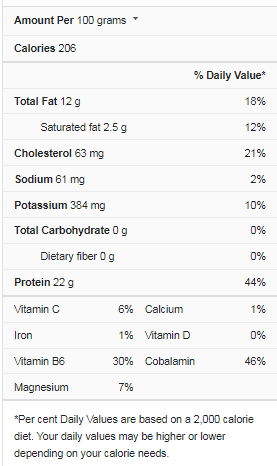When purchasing fish, you must inspect it thoroughly before it is wrapped. Please don’t hesitate to ask them to smell it at the counter. Fresh fish will have no odor and appear moist, glistening, and bright in color. You don’t want to risk getting food poisoning if you eat rotten fish because it won’t be pleasant. To avoid it rotting before you get a chance to prepare and enjoy it, make sure you cook it within 24 hours of purchasing it.
Fish may be stored in either a freezer or a refrigerator before being eaten, and it keeps well in both. However, the meat will rot with time and no longer be safe or healthful to cook with. To determine if the fish has gone wrong, consider the sell-by date printed on the container, the location where the fish was kept, and the texture and smell of the fish. It’s advisable to throw out seafood that exhibits indications of spoilage to avoid food illness.
Fish Nutrition Fact
How To Tell Fish Is Bad?
When you buy fish, you usually want to cook it the same day or within 24 hours. Make sure you inspect it before buying it and before cooking it.
You don’t want to waste your time with rotten seafood, so make sure it’s fresh before you start preparing it. It’s elementary to detect if fish is fresh or not.
You can tell whether something has gone wrong by using your senses of smell, touch, and sight. Let’s look at some simple methods for determining whether or not a fish is rotten.
1. It Has A Fishy Smell
You’d assume fish would have a fishy odor because, well, it’s fish, right? That isn’t the case at all. When fish smells fishy, it’s usually because it’s gone wrong.
Another indicator of sick fish is the smell of ammonia. There shouldn’t be much of a smell if any at all.
2. Translucent Or Grey
Fish that are greyish in color, drab in appearance, or translucent are signs that they have rotted.
On the other hand, fish comes in various hues, such as salmon, which should be reddish pink, cod, which should be white, and tuna, which should be a dark red or pinkish tint. When purchasing a fillet, it should appear moist and glistening.
If you’re not sure, just by looking at it, give it a sniff and feel to be sure it’s still fresh.
3. Slimy
A slimy fish is a symptom that it has been ruined. If it’s gone wrong, you might detect a milky-like flesh on it as well. It’s natural for a fish to be damp when you buy it, and you don’t want it to be sticky or slimy, though.
4. Check The Sell-By Date
if you’ve been storing the fish in the fridge or forgot it was there, check the sell-by date before deciding to fix it once you’ve discovered it. Throw it away if it’s more than two days past its expiration date. After that date, it doesn’t last long in the refrigerator. Soon after the sell-by date, it will begin to spoil. Please put it in the freezer as soon as you arrive home to keep the fish from going bad. The same considerations apply if the packet of fish has a use-by date rather than a sell-by date. The use-by date indicates that it will spoil if the fish is not consumed by that date.
Cooked fish can be kept in the refrigerator for five days beyond the sell-by date. Before putting it in the fridge, store it in an airtight container. You can also freeze the fish if you know you won’t eat it within that time range. Most people will throw away the original packaging, so make a note of the sell-by date on the container so that when you take it out of the fridge or freezer, you’ll know whether it’s still edible or needs to be thrown away.
What Is The Best Way To Store Fish?
Varied types of fish keep for different amounts of time in the freezer. Lean fish, on average, retains its quality better than fatty fish: Salmon, for example, has a two- to three-month shelf life, whereas cod has a six- to eight-month shelf life. The high quantities of fat in salmon, herring, mackerel, and other similar fish will oxidize and produce “off” flavors after a few months because most freezer packaging does not entirely remove air from the food it preserves.
Because spoiling cannot occur in the freezer, the concern with frozen fish is one of deteriorating quality rather than food safety. It would help if you dated the package when you freeze fish and plan to utilize it within a few months. Alternatively, use the fish in a casserole, fish paste, or seafood dip to serve with crackers or vegetables to conceal any flavor and texture inadequacies.
How Can You Make Fish Last Longer?
Keeping fish refrigerated at all times is the most straightforward approach to keep it fresh for a long time. If you have a refrigerator, keep it in the coldest portion (40F or less) after each use. Raw fish should be stored in the refrigerator for up to two days.
Consider keeping already prepared fish is firmly sealed containers to keep it free of moisture and other pathogens. Cooked fish should be kept refrigerated for 3 to 4 days.
A freezer will come in helpful if you want to keep your fish for a more extended amount of time. Raw fish can be frozen for 3-8 months at 0°F, while prepared fish can be frozen for three months. Another way to assess whether a fish is still edible is to use the “Shelf-Life” method. Whether the fish was store-bought, processed, or freshly caught has a colossal effect on shelf life.
It’s relatively simple to prepare store-bought, processed fish. They have “sell-by” and “use-by” dates printed on their packaging. Although not ideal, this is a helpful tool for judging whether or not a fish is still edible.
When fish is caught fresh, it is best to gut and clean it right away before storing it in the fridge or freezer.
Furthermore, fresh fish should be consumed within 36 hours; however, if properly processed and refrigerated, the fish can be used after two to three days.
When refrigerating, aim for a temperature of 40 degrees Fahrenheit or lower.
According to the United States Department of Agriculture website, fish can be frozen forever; however, it is recommended that the fish be used within three to eight months following freezing. 0 degrees Fahrenheit is the freezing point.
Conclusion
The shelf life of fish is determined by some factors, including the sell-by date, the technique of preparation, and how the fish was stored. Fish is a beautiful leading dish choice because of its abundance, established health advantages, and high protein content. Omega-3 fatty acids (commonly known as good cholesterol) found in fish have been shown to reduce the risk of heart disease and help with various other health issues.
It’s critical to determine if fish has gone wrong before cooking it. One of the most common causes of food poisoning is fish, and the scent is one of the most evident indications of rotten fish. It’s also possible to know by its appearance and how it feels. I’ll walk you through a step-by-step procedure for determining whether or not fish has spoiled before cooking it.




